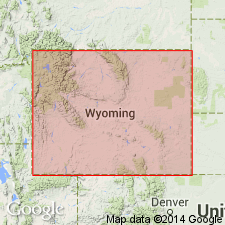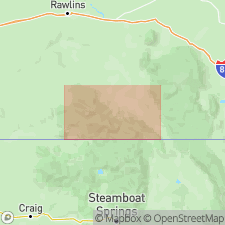
- Usage in publication:
-
- Sierra Madre Granite
- Modifications:
-
- Named
- Geochronologic dating
- Dominant lithology:
-
- Granite
- AAPG geologic province:
-
- Northern Rocky Mountain region
Summary:
Named for the major Proterozoic rock of the Sierra Madre Range, Carbon Co, WY, Northern Rocky Mountain region. No type locality designated. Consists of pink to red alaskitic granite. Has three principal phases: a fine- to medium-grained protoclastic phase, a medium- to coarse-grained massive equigranular phase, and a porphyritic phase with a fine-grained or graphic coarse-grained groundmass. A microcline-biotite augen gneiss forms a marginal unit intergrading with the granite and with Big Creek Gneiss (new). Mineralogy of the phases discussed. Chemical, petrologic, and isotopic data. Geologic map. Is nearly identical to Boulder Creek Granodiorite of the Colorado Front Range. Has an 1680 +/-50 m.y. isochron. Of Proterozoic age. Discordant, fine-grained granitoid dikes of Sierra Madre commonly intrude Green Mountain Formation (new) and rarely Big Creek Gneiss (new) and formations (five newly named) of the Libby Creek Group. Is younger than Encampment River Granodiorite (new).
Source: GNU records (USGS DDS-6; Denver GNULEX).

- Usage in publication:
-
- Sierra Madre Granite
- Modifications:
-
- Overview
- AAPG geologic province:
-
- Northern Rocky Mountain region
Summary:
Occurs in the southern Sierra Madre, WY, Northern Rocky Mountain region, as a composite batholith consisting of red microcline alaskite. Occurs as a wide variety of megascopic and microscopic textures. Three principal intergrading phases [see Divis, 1976]. Its age of 1,680 +/-20 m.y. corresponds well with the Boulder Creek Granodiorite of the Front Range in CO, Pinto Diorite and other plutons of the Little Belt Mountains, WY [MT].
Source: GNU records (USGS DDS-6; Denver GNULEX).
For more information, please contact Nancy Stamm, Geologic Names Committee Secretary.
Asterisk (*) indicates published by U.S. Geological Survey authors.
"No current usage" (†) implies that a name has been abandoned or has fallen into disuse. Former usage and, if known, replacement name given in parentheses ( ).
Slash (/) indicates name conflicts with nomenclatural guidelines (CSN, 1933; ACSN, 1961, 1970; NACSN, 1983, 2005, 2021). May be explained within brackets ([ ]).

